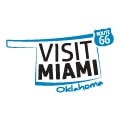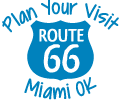Coleman Theatre Beautiful
Located at 103 N Main,this facility offers guided tours on Tuesday through Friday from 10 a.m. to 2 p.m. Saturday tours are from 10 a.m. to noon. Tours are free but donations are accepted.
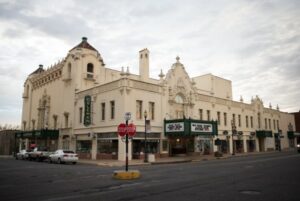
Charles Banks Wilson Building
Across Main Street from the Coleman Theatre, this building was built in 1910 as a Millinery Shop for Mrs. Annie Green. For many years, Charles Banks Wilson, a graduate of Miami High School and famous Oklahoma artist, used the upstairs for his studio. He was often referred to as the artist on Main Street. Charles Banks Wilson’s art work is displayed at the Oklahoma State Capital, the Gilcrease Museum, and in homes all over Oklahoma.
Federal Building Walk
Down First Street to A Street. Enter the side door of the Federal Building (off of 1st Street), noting the original lights on the outside wall. The first stamp was sold at the new Post Office in Miami at 1 p.m. on August 11, 1933. The three-story Federal Building contained a post office, federal offices and a courtroom. On entering, look at the mural on the south wall. This 1996 mural by local artist, Nick Calcagno, depicts the Eagle Picher Central Mill built in 1932. Mr. Calcagno chose to work on the painting at the Roosevelt Elementary School so the children could observe him at work. When leaving by the front door, notice the original lamp posts. The structure of the Federal Building has remained the same.
St. James Court
This building is listed on the National Register of Historic Places. It was originally erected as the Commerce Building in 1918 at a cost of $125,000. Enter on the south side of the building and notice the tile floor with the Native American design and the original name of the building. Looking up you will see the original ceiling lights and marble on the walls. The building now has loft apartments available and dining at the St. James Café downstairs.
Courthouse
Look south toward the Courthouse. The new Courthouse was constructed in 2009. The old courthouse, built in 1916–1917 was built at a cost of $75,000 and consisted of four stories and a basement. Due to structural issues, the new courthouse was built and placed on the north end of the complex and the old courthouse on the south end, was torn down. Note the two Spanish American War Cannons that were shipped from Fort Bliss and Fort Sam Houston and arrived in Miami in September of 1923. The cannons were refurbished in 1958 and again in 2002. Also on the property stands one of the 3,000 replicas of the Statue of Liberty to celebrate the 40th anniversary of Boy Scouts. Local Boy Scouts in the area raised the funds for the statue dedicating it in September 1950. The statue was sent to the foundry to be refurbished in 2000. A centennial clock was placed on the courthouse grounds in 2008 as part of the state wide celebration of Oklahoma’s 100th Birthday.
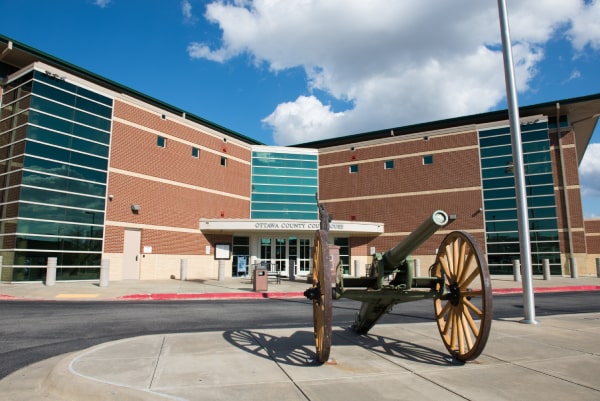
Nesbitt Building
Walking on the north side of East Central toward Main Street, you will see the Nesbitt Building. This building was built by John G. Austin in 1916–1917 at a cost of $7,000. Austin and other lawyers occupied the top floor in the building with other businesses on the first floor. In 1952, Frank Nesbitt bought the building making major interior renovations. The exterior was kept the same except for replacing the Austin name with Nesbitt. The second floor of this building has continued to house law offices since 1917. The first floor, which housed Doan’s Pharmacy in 1917, has been occupied by Photo Abstract since the 1950’s. Photo Abstract has been in Miami since 1917, because they agreed to furnish photo duplex copies of deeds etc. to County Register of Deeds, Ottawa County became only the second recording district of the world to adopt photography as the means of maintaining its public records.
Wagoner Building
This building was built as a grocery store for W.A. Wagoner around 1899 and has been occupied by Bomford, Couch and Wilson Insurance since 1924. The building was renovated in 2002. Notice the lamp posts and also the limestone wall on the alley side of the building.
First National Bank
First National Bank has been part of Miami history since 1900. The six floor bank and office building was dedicated on February 22, 1930. As you look inside note the beautiful interior and the eagle symbolizing the bank as a national bank. The bronze sculpture “Generation to Generation” by Mischel Riley was added during the bank’s Centennial Celebration in 2000. The display now sits at the corner of 2nd Street & North Main.
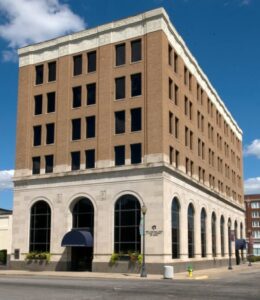
Security Bank Area
From the Security Bank parking lot, look across Main Street to the Cardin Building. It was built in 1917 to house the Miami Trust and Savings Bank. In 1922, the Security Bank and Trust began occupying the first floor. Looking back the other direction from the parking lot, you will see a mural on the Osborn Drugs wall. The Centennial mural, painted by Nick Calcagno, depicts “Early Days of Miami” while two youth read from the Centennial Book Reflections.
Hadley Building
Across Main Street from the First National Bank Building you will see the Hadley Building. The building is currently operated as KGLC 110.9 FM Radio Station. Depending on your generation, residents remember this drug store by many different names: Palace, Hadley, or Crown. A dated 1908 souvenir postcard folder and a circa 1903 photo of Botts shows the building with limestone wall facing Central. The next three buildings are also shown in the photo and postcard. The postcard shows Interurban tracks in the middle of the street and the picture shows a dirt street. The two story brick was added to the Hadley Drug in 1916. The building currently houses the local radio station, KGLC.
Beauty College Building
The Beauty College Building renovation in 1998 uncovered the façade of cast iron that was purchased by the piece from a catalog out of St. Louis. It is one of only sixteen of its kind in Oklahoma. It once housed a variety store, grocery store, and for years was home to Faulkenberry’s ready to wear for women and children. Currently operated as The Dance Academy.
Mabon Building
Walking north down Main Street you will see the Mabon Building which was built in 1917 at a cost of $30,000. The structure included a six foot fire wall of cream colored brick above the massive metal cornice. The name Mabon was set in this wall. The third story was especially designed for the Elks Hall.
Chapter’s Bookstore
This was originally Jackson Drug Company #6 built in 1918–1919. Look inside. Note the original door. The interior features 14-foot ceilings, dark oak molding, and 10×14 foot mahogany windows in the pattern of the original windows. Much of the original drug store tile was discovered under layers of adhesives and paint before it was restored. Note the same name of the drug store in the tile.
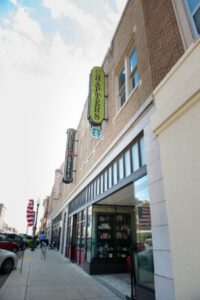
Miami Hotel
This seven story building, which contained 121 rooms when built in 1917–1918 quickly became the headquarters for commercial travelers and tourists. The beauty of the interior and dining room and banquet facilities added to the charm of the hotel. A typed postcard mailed June 4, 1918 said, “Am sending you a menu of the First Dinner served in the New Hotel Miami, which opened today.” The menu listed foods a-la-carte with names of one of Miami’s leading citizens. Today the building is Miami Towers and is owned and operated by the Miami Housing Authority.
Robinson Building
Across Main Street from the Miami Towers is the final building on the walking tour. The Robinson Building was built in 1918 at a cost of $6,000. In 1992, the building was purchased by a church and restored one floor at a time by volunteer members of the ministry. Many of the features inside the church are the original décor and replicas of items from the early 1900’s. The building sets diagonal from the Coleman Theatre.
